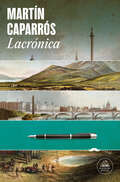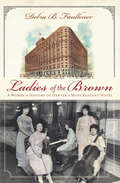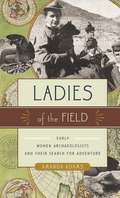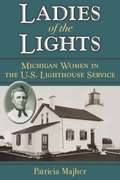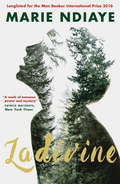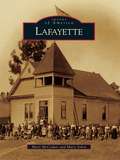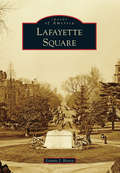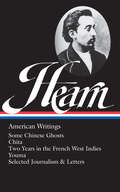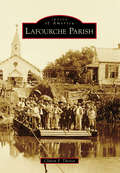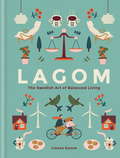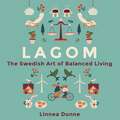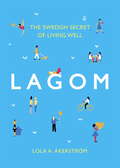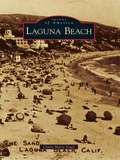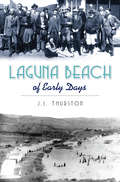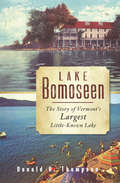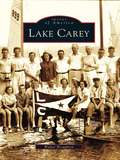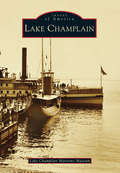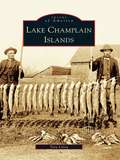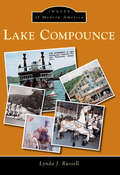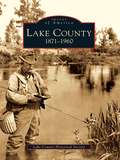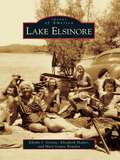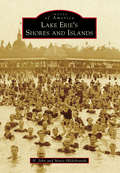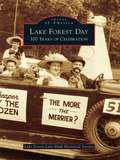- Table View
- List View
Lacrónica
by Martín Caparrós*Premio Ortega y Gasset de Periodismo a la Trayectoria profesional 2023* 40 años de periodismo narrativo condensados en una obra magistral; Lacrónica reafirma a Caparrós como una de las voces imprescindibles de la literatura en nuestro idioma. «Martín Caparrós representa la fuerza del periodismo que se hace en español.» Pepa Bueno, directora de El País Lacrónica sería un «grandes éxitos» de Caparrós, una compilación de sus mejores crónicas, si no fuera porque allí, además, el autor cuenta su historia en el periodismo y reflexiona sobre cómo escribe lo que escribe, cómo piensa lo que piensa, cómo se hace lo que hace. Entre recuerdos de su primer jefe, Rodolfo Walsh, y de su último maestro, Tomás Eloy Martínez, Caparrós da una lección de escritura de la no ficción que las facultades de periodismo de España y América Latina ahora emplean para enseñar esta materia. Todo lo que usted siempre -o nunca- quiso saber sobre Lacrónica, ese extraño género del periodismo que empezó a poner por escrito el continente americano y tiene el don de permitirse la duda, brilla en esta obra que, casi sin querer, se volvió ineludible. La crítica ha dicho: «El mejor cronista actual de América Latina: un soberbio entrevistador, un viajero dotado de cultura enciclopédica y de una fina ironía.» Roberto Herrscher, La Vanguardia «Este libro reúne una sorprendente muestra de la práctica de la crónica, articulado a modo de crónica del cronista, ya que no es solo un compendio de piezas selectas, sino un recorrido por la responsabilidad de la propia mirada y la adicción a la escritura».Francisco Solano, Babelia, El País «Lacrónica es uno de los libros con los que más he disfrutado de los últimos tiempos. Martín Caparrós habla con una lucidez asombrosa, y esos pasajes que le dan coherencia y vertebración al volumen resultan definitivos para saber en qué consiste escribir crónica y qué papel ha jugado esa disciplina en la literatura en castellano».Nadal Suau, El Español Sobre Ñamérica: «El conjunto es el resultado de un esfuerzo superheroico por contar y pensar de nuevo —y con nuevas ideas— medio continente.»Jorge Carrión, La Vanguardia «El autor argentino despliega en Ñamérica el retrato coral de un continente marcado por los tópicos literarios, el maniqueísmo histórico y la desigualdad económica.»Andrea Aguilar, Babelia, El País«Martín Caparrós lo ha vuelto a hacer. En Ñamérica entrecruza crónica periodística, ensayo, poesía... Y sale lo que se parece mucho a un hito literario sobre América Latina y sus circunstancias.»Edu Galán, Zenda «Un ensayo abrumador y fascinante que persigue glosar un continente y a sus 420 millones de habitantes.»Daniel Arjona, El Confidencial
Ladies of the Brown: A Women's History of Denver's Most Elegant Hotel (Landmarks)
by Debra B. Faulkner&“Amusing and little-known anecdotes&” about the hotel&’s female guests including Hillary Rodham Clinton, Zsa Zsa Gabor, Joan Baez, Helen Keller, and others (The Denver Post). Since the day it opened in 1892, Denver&’s Brown Palace Hotel has been the Mile High City&’s foremost destination for high-powered business travelers, celebrities, royalty and politicians. In Ladies of the Brown, hotel historian and archivist Debra B. Faulkner introduces readers to some of the hotel&’s most fascinating and famous female visitors, residents and employees. From Denver&’s &“Unsinkable&” Molly Brown and Romania&’s Queen Marie to Zsa Zsa Gabor, Mamie Eisenhower and many, many more, these intriguing characters play leading roles in true tales of romance, scandal, humor and heartbreak. This collection of stories is integral to the history of the Brown Palace and Denver, offering a glimpse into the lives of generations of women from all walks of life. &“Crafted by Brown Palace historian and archivist Debra Faulkner, this well written, well-researched and thoroughly entertaining book presents amazing stories one can hardly believe are true.&” —Colorado Country Life, &“The Year&’s Best Books&” &“What fun we had learning about this amazing assortment of characters, all real, and this building so well-appointed and enduring.&” —Mountain States Collector
Ladies of the Field: Early Women Archaeologists and Their Search for Adventure
by Amanda AdamsThe first women archaeologists were Victorian era adventurers who felt most at home when farthest from it. Canvas tents were their domains, hot Middle Eastern deserts their gardens of inquiry and labor. <P><P>Thanks to them, prevailing ideas about feminine nature - soft, nurturing, submissive - were upended. Ladies of the Field tells the story of seven remarkable women, each a pioneering archaeologist, each headstrong, smart, and courageous, who burst into what was then a very young science. Amanda Adams takes us with them as they hack away at underbrush under a blazing sun, battle swarms of biting bugs, travel on camelback for weeks on end, and feel the excitement of unearthing history at an archaeological site. Adams also reveals the dreams of these extraordinary women, their love of the field, their passion for holding the past in their hands, their fascination with human origins, and their utter disregard for convention.
Ladies of the Lights: Michigan Women in the U.S. Lighthouse Service
by Patricia Majher"A great read about some great ladies, Pat Majher'sLadies of the Lightspays long overdue homage to an overlooked part of Great Lakes maritime history in which a select group of stalwart women beat the odds to succeed in a field historically reserved for men. " ---Terry Pepper, Executive Director of Great Lakes Lighthouse Keeper's Association Michigan once led the country in the number of lighthouses, and they're still a central part of the mystique and colorful countryside of the state. What even the region's lighthouse enthusiasts might not know is the rich history of female lighthouse keepers in the area. Fifty women served the sailing communities on Lakes Huron, Michigan, and Superior, as well as on the Detroit River, for more than 100 years. From Catherine Shook, who raised eight children while maintaining the Pointe Aux Barques light at the entrance to Saginaw Bay; to Eliza Truckey, who assumed responsibility for the lighthouse in Marquette while her husband fought for four years in the Civil War; to Elizabeth Whitney, whose combined service on Beaver Island and in Harbor Springs totaled forty-one years---the stories of Michigan's "ladies of the light" are inspiring. This is no technical tome documenting the minutiae of Michigan's lighthouse specifications. Rather, it's a detailed, human portrait of the women who kept those lighthouses running, defying the gender expectations of their time. Patricia Majher is Editor ofMichigan Historymagazine, published by the Historical Society of Michigan. Prior, she was Assistant Director of the Michigan Women's Historical Center and Hall of Fame in Lansing, Michigan. In addition, she has been writing both advertising and editorial copy for almost thirty years and has been a frequent contributor to Michigan newspapers and magazines.
Ladivine
by Marie NDiayeLonglisted for the Man Booker International Prize 2016Clarisse Rivière's life is shaped by a refusal to admit to her husband Richard and to her daughter Ladivine that her mother is a poor black housekeeper. Instead, weighed down by guilt, she pretends to be an orphan, visiting her mother in secret and telling no-one of her real identity as Malinka, daughter of Ladivine Sylla. In time, her lies turn against her. Richard leaves Clarisse, frustrated by the unbridgeable, indecipherable gulf between them. Clarisse is devastated, but finds solace in a new man, Freddy Moliger, who is let into the secret about her mother, and is even introduced to her. But Ladivine, her daughter, who is now married herself, cannot shake a bad feeling about her mother's new lover, convinced that he can bring only chaos and pain into her life. When she is proved right, in the most tragic circumstances, the only comfort the family can turn to requires a leap of faith beyond any they could have imagined.Centred around three generations of women, whose seemingly cursed lineage is defined by the weight of origins, the pain of alienation and the legacy of shame, Ladivine is a beguiling story of secrets, lies, guilt and forgiveness by one of Europe's most unique literary voices.Translated from the French by Jordan Stump
Lafayette
by Mary Mccosker Mary SolonToday's Lafayette is a modern East Bay suburb with a long and intriguing history of people, agriculture, and commerce. The story began in the summer of 1846, when Elam Brown and 13 families left St. Joseph, Missouri, in wagon trains and embarked on a sixmonth journey west to establish new homes and lives. By February 1848, Brown and his family had purchased the Rancho Acalanes in Contra Costa County from a San Francisco financier and had established the settlement that would later became Lafayette. Gradually Brown sold his land to other settlers, and the community began to grow. Eventually homes, stores, roads, schools, and churches were built. In these pages, the genesis of Lafayette, along with the story of its creators and early residents, is revealed in stirring early imagery.
Lafayette Square
by Lonnie J. HoveyLafayette Square's rich history dates back to the founding of the District of Columbia when Pierre L'Enfant planned it as part of the grounds for the president's house. The square was one of the first open spaces within the city to be designed as a public park. Across Pennsylvania Avenue from the White House, the park's neighborhood became home to presidents, vice presidents, cabinet members, diplomats, inventors, journalists, heroes, authors, scientists, law breakers, and scoundrels. Today, the square and its sculptures are surrounded by government offices, but symbolically, it is the White House's front yard, making it an attractive destination. Using historic photographs, Lafayette Square captures the square's social, political, and architectural history, highlighting important past events.
Lafcadio Hearn: Some Chinese Ghosts / Chita / Two Years in the French West Indies / Youma / selected journalism and letters (The Library of America #190)
by Lafcadio Hearn Christopher BenfeyA translator of Flaubert and Gautier, Lafcadio Hearn was the master of a gaudy and sometimes self-consciously decadent literary style, but he was also a tough-minded and keenly observant reporter, with an eye for the offbeat, the sensual, and occasionally the gruesome. The writings of his American years collected in this Library of America volume—on subjects as wide ranging as comparative folklore, the history of musical instruments, French literary avant-gardes, and New Orleans voodoo—reveal an omnivorous curiosity and an always eclectic sensibility.Some Chinese Ghosts (1887), a stylized retelling of ancient legends, foreshadows Hearn's later fascination with Asian themes. The exquisitely crafted novels Chita (1889), about the devastation wrought by a Louisiana hurricane, and Youma (1890), about a slave rebellion in Martinique, epitomize his writing at its most luxuriantly romantic, alert to the interactions of diverse cultures and suffused with imagistic splendor. His extraordinary travel book Two Years in the French West Indies (1890), presented here with the many illustrations from its first edition, provides a richly impressionistic account of his long stay on Martinique and other Caribbean islands.More than two dozen examples of Hearn's journalism from the 1870s and 1880s are also included here, evoking vanished worlds with incomparable vividness: a raucous African-American nightclub on the Cincinnati waterfront; an execution; scenes of Mardi Gras and the New Orleans French Quarter; an uncharted village of Filipino fishermen in a remote Louisiana bayou. The volume is rounded out with a revealing selection of Hearn's impassioned letters, many published here for the first time in unexpurgated form.LIBRARY OF AMERICA is an independent nonprofit cultural organization founded in 1979 to preserve our nation’s literary heritage by publishing, and keeping permanently in print, America’s best and most significant writing. The Library of America series includes more than 300 volumes to date, authoritative editions that average 1,000 pages in length, feature cloth covers, sewn bindings, and ribbon markers, and are printed on premium acid-free paper that will last for centuries.
Lafourche Parish (Images of America)
by Clifton TheriotLafourche is a parish rich in history and culture known for its close-knit, family-centered communities. The towns and communities of Lafourche were settled along its namesake, Bayou Lafourche, which bisects the parish from its northern boundary to its southern boundary at the Gulf of Mexico. Because of the continuous pattern of homes and businesses built along the bayou, many refer to the bayou as the "Longest Street in the World." The parish was originally inhabited by Native American tribes and later by European, African, and English settlers. Many of the residents of Lafourche can trace their ancestry back to these early settlers, strengthening the sense of community that is distinctive to southern Louisiana. The fertile bayou delta fostered small vegetable farms as well as large sugarcane plantations that continue to thrive. The numerous waterways and marshes of the parish produce bountiful catches of fish, seafood, and other wildlife, giving rise to its reputation as a sportsmen's paradise. The parish's economy is also made up of a shipbuilding industry and the onshore and offshore oil industry.
Lagom: The Swedish Art Of Balanced Living
by Linnea DunneStep aside Hygge. Lagom is the new Scandi lifestyle trend taking the world by storm. This delightfully illustrated book gives you the lowdown on this transformative approach to life and examines how the lagom ethos has helped boost Sweden to the No.10 ranking in 2017's World Happiness Report.Lagom (pronounced 'lah-gom') has no equivalent in the English language but is loosely translated as 'not too little, not too much, just right'. It is widely believed that the word comes from the Viking term 'laget om', for when a mug of mead was passed around a circle and there was just enough for everyone to get a sip. But while the anecdote may hit the nail on the head, the true etymology of the word points to an old form of the word 'lag', which means 'law'.Far from restrictive, lagom is a liberating concept, praising the idea that anything more than 'just enough' is a waste of time. Crucially it also comes with a selflessness and core belief of responsibility and common good. By living lagom you can live a happier and more balanced life, reduce your environmental impact, improve your work-life balance, free your home from clutter, enjoy good food the Swedish way, grow your own and learn to forage, and cherish the relationships with those you love.
Lagom: The Swedish Art of Balanced Living
by Linnea DunneStep aside Hygge. Lagom is the new Scandi lifestyle trend taking the world by storm. This delightfully illustrated book gives you the lowdown on this transformative approach to life and examines how the lagom ethos has helped boost Sweden to the No.10 ranking in 2017's World Happiness Report. Lagom (pronounced 'lah-gom') has no equivalent in the English language but is loosely translated as 'not too little, not too much, just right'. It is widely believed that the word comes from the Viking term 'laget om', for when a mug of mead was passed around a circle and there was just enough for everyone to get a sip. But while the anecdote may hit the nail on the head, the true etymology of the word points to an old form of the word 'lag', which means 'law'.Far from restrictive, lagom is a liberating concept, praising the idea that anything more than 'just enough' is a waste of time. Crucially it also comes with a selflessness and core belief of responsibility and common good. By living lagom you can: Live a happier and more balanced life Reduce your environmental impact Improve your work-life balance Free your home from clutter Enjoy good food the Swedish way Grow your own and learn to forage Cherish the relationships with those you love
Lagom: The Swedish Art of Balanced Living
by Linnea DunneDiscover the Swedish ethos of balanced living with Lagom.Lagom (pronounced 'lar-gom') has no equivalent in the English language but is loosely translated as 'not too little, not too much, just right'. It is widely believed that the word comes from the Viking term 'laget om', for when a mug of mead was passed around a circle and there was just enough for everyone to get a sip. But while the anecdote may hit the nail on the head, the true etymology of the word points to an old form of the word 'lag', which means 'law'.Far from restrictive, lagom is a liberating concept, praising the idea that anything more that 'just enough' is a waste of time. Crucially it also comes with a selflessness and core belief of responsibility and common good. By living lagom you can live a happier and more balanced life, reduce your environmental impact, improve your work-life balance, free your home from clutter, enjoy good food the Swedish way, grow your own and learn to forage, and cherish the relationships with those you love.Linnea Dunne was born and raised in Sweden, where she started her writing career as a columnist at the local newspaper aged 15. She left for Ireland a few years later and eventually moved to London, where she studied Creative Writing and Political Communications. She now lives in Dublin with her husband and two half-Swedish kids, trying to achieve that lagom balance against all odds. Linnea's work on subjects ranging from motherhood to women's rights and media narratives has been published by (among others) the Irish Times, the Guardian and the Irish Independent, and she also works as Editor of Scan Magazine. The irony of the fact that she escaped her home country, never made it back, and now spends the majority of her day writing about Scandinavian culture, innovation and trends is lost on no one.(P) 2017 Octopus Publishing Group
Lagom: The Swedish Secret of Living Well
by Lola A ÅkerströmPerfect for fans of The Little Book of Hygge and Norwegian Wood, find the balance in life that is just right for you. Let Lola A. Åkerström, Editor-in-chief of Slow Travel Stockholm, be your companion to all things lagom.As the Swedish proverb goes, 'Lagom är bäst' (The right amount is best). Lagom sums up the Swedish psyche and is the reason why Sweden is one of the happiest countries in the world with a healthy work-life balance and high standards of living.Lagom is a way of living that promotes harmony. It celebrates fairness, moderation and being satisfied with and taking proper care of what you've got, including your well-being, relationships, and possessions. It's not about having too little or too much but about fully inviting contentment into our lives through making optimal decisions. Who better than Lola A. Åkerström to be your lagom guide? Sweden-based Lola is an award-winning writer, photographer , and editor-in-chief of Slow Travel Stockholm and she offers us a unique vantage point when it comes to adopting elements of a lagom lifestyle.Full of insights and beautiful photographs, taken by Lola herself, this authentic book will help you make small, simple changes to your every day life - whether that's your diet, lifestyle, money, work or your home - so you can have a more balanced way of living filled with contentment.
Lagom: The Swedish Secret of Living Well
by Lola A ÅkerströmPerfect for fans of The Little Book of Hygge and Norwegian Wood, find the balance in life that is just right for you. Let Lola A. Åkerström, Editor-in-chief of Slow Travel Stockholm, be your companion to all things lagom.As the Swedish proverb goes, 'Lagom är bäst' (The right amount is best). Lagom sums up the Swedish psyche and is the reason why Sweden is one of the happiest countries in the world with a healthy work-life balance and high standards of living.Lagom is a way of living that promotes harmony. It celebrates fairness, moderation and being satisfied with and taking proper care of what you've got, including your well-being, relationships, and possessions. It's not about having too little or too much but about fully inviting contentment into our lives through making optimal decisions. Who better than Lola A. Åkerström to be your lagom guide? Sweden-based Lola is an award-winning writer, photographer , and editor-in-chief of Slow Travel Stockholm and she offers us a unique vantage point when it comes to adopting elements of a lagom lifestyle.Full of insights and beautiful photographs, taken by Lola herself, this authentic book will help you make small, simple changes to your every day life - whether that's your diet, lifestyle, money, work or your home - so you can have a more balanced way of living filled with contentment.
Laguna Beach
by Claire Marie VogelAs one of the West Coast's most unique and beautiful resort cities, Laguna Beach has thrived as an enduring enclave of art culture, a destination of hidden beaches, and a coastline rich in natural wonders, which its officials and residents strive to maintain. Settlers arrived in the 1870s, and by the summer of 1918 Laguna's first art gallery opened, featuring works by a growing collective of local artists. Hundreds of visitors came on opening day and, in the next month, 2,000 more visited the small art gallery. In 1932, Laguna started what would become a world-renowned event called the Festival of the Arts and later added the equally famous Pageant of the Masters. Since its simple beginnings as a small village situated where Laguna Canyon opens onto the Pacific shoreline to the reason there are traffic jams on Coast Highway during hot-month weekends, this southern Orange County jewel has continued to be a great draw for beachgoers, painters, and nature lovers the world over.
Laguna Beach of Early Days
by J. S. ThurstonThe family of Laguna Beach founding father Joseph S. Thurston claimed a shack in Aliso Canyon in 1871, when he was just three years old. Thurston’s personal account of growing up in Laguna presents an intimate look at the settler’s hardships, relationships and perseverance. Recalling these struggles, he paints a graphic picture of early citizens and their contributions to the growth and development of this community. Originally published in 1947, this historical narrative serves as a marvelous, unique glimpse of a bygone era. Thurston’s grandson, Kelly H. Boyd, offers this revised edition for a new generation.
Lake Bomoseen: The Story of Vermont's Largest Little-Known Lake
by Donald H. ThompsonLake Bomoseen- the largest lake entirely within Vermont's borders- once attracted thousands of visitors each year. Its resorts and restaurants welcomed travelers of all stripes, from Walt Disney and Harpo Marx to humble groups of workers and families. Crowds flocked to beaches and picnic areas during the daytime, and headliners like Frank Sinatra and Louis Armstrong kept the Casino at the lake buzzing late into the night. Donald H. Thompson describes these and other glamorous moments in Lake Bomoseen's past and explains how the area has evolved since the last hotels and dance halls closed their doors. Carefully researched and accompanied by dozens of rare images, this is the definitive history of one of Vermont's finest spots.
Lake Carey (Images of America)
by Walter BroughtonLake Carey is a summer community of several hundred families in the Endless Mountains of northeast Pennsylvania. Lake Carey's story begins in 1874, when the narrow-gauge Montrose Railroad began service to the 262-acre glacial lake named Marcy's Pond. Cottages with gingerbread porches sprang up almost overnight; hotels, steamboats, and picnic groves swiftly followed. As World War I drew near, the renamed lake and its community were a fixture on the regional map. Their resort status was short-lived, however, as the changing American family and the advent of the automobile began an inexorable transformation. First to go were the crowded steamboats and excursion trains. A new, quieter era began, dominated by rental cottages and--at Lake Carey--regattas. Through vintage photographs, Lake Carey documents how the people who gathered here retained their strong sense of community born of the shared privilege of a place at the lake and the pleasures of summer pastimes.
Lake Champlain
by Lake Champlain Maritime MuseumNestled between the Adirondacks of New York and Vermont's Green Mountains, Lake Champlain offers 120 miles of tranquil beauty with a rich, bustling history. Picturesque waterfront communities established in the 18th century recall the era when the Champlain Valley's natural resources--iron, lumber, granite, marble, and potash--were shipped to distant ports on lake sloops and schooners. By the early 19th century, Lake Champlain was connected with the canals of New York and Quebec, and the resulting economic boom lasted for 100 years. Apples, hay, bricks, and finished goods were shipped on thousands of workaday canal boats that were also floating family homes. Massive steamboats carried travelers and tourists drawn to the fresh country air, and lakefront camps sprang up everywhere. Automobiles traveled over Lake Champlain on ferries and bridges. Through stunning historical images from the archives of Lake Champlain Maritime Museum and other regional collections, Lake Champlain tells the story of this busy commercial corridor and pastoral recreational destination.
Lake Champlain Islands
by Tara LiloiaOn July 3, 1609, French explorer Samuel de Champlain and his group canoed south from Canada into an expansive lake and found four islands. Those islands are now the Lake Champlain Islands, and it was that trip that gave birth to Vermont and sparked 400 years of history. Located in the far northwest corner of the state, the islands are well known as a shoreline retreat for all of New England, with their small-town feel and picturesque farmlands. In this birthplace of Vermont, with its rich soil, early settlers found success growing local varieties of apples, which they shipped by steamboat directly to international cities. Several large deposits of unique, dark limestone brought marble trade to the area, and these materials are still mined in working quarries today. The Lake Champlain Islands are a tranquil, yet vibrant area of Vermont, where historical buildings are often used as schools, museums, libraries, and private homes.
Lake Compounce (Images of Modern America)
by Lynda J. RussellFounded in October 1846 by two local families, Lake Compounce began its transformation from a rustic summer resort into a bustling amusement park. Gad Norton and Isaac Pierce teamed together to build a park that utilized the lake's natural appeal forswimming, boating, and picnicking. Through vintage photographs, Lake Compounce highlights the park's long history of big bands, the Crocodile Club, the Wildcat roller coaster, and the William Gillette train. For generations, the park has been able to maintain its status as a local treasure while expanding and growing into what is today recognized as "America's pioneer playground."
Lake County: 1871-1960
by Lake County Historical SocietyNative Americans roamed the beautiful lands of northern Michigan for many years, leaving a legacy of mature forests, clear waters, and plentiful game. By 1871, waves of immigrants were arriving from Europe, as well as Union soldiers after the Civil War. These pioneers brought with them the tools, know-how, and determination to transform the wild land into an economy based on the timber, railroads, and farming. Schools, churches, businesses, and tourism blossomed. The county's 156 lakes and 46 trout streams offered pristine settings for swimming, boating, hunting, and fishing. Resorts, sporting clubs, and cottage colonies sprang up to meet the needs of seasonal visitors. Early fishing guide and hotelier Andrew J. Bradford, financiers Curtis W. MacPhail and Robert J. Smith, philanthropist Martin Johnson, and others nurtured the growth of the communities. The Civilian Conservation Corps replanted the forests and built roads, the African American resort of Idlewild showcased black entertainers, and Raymond W. Overholzer built Shrine of the Pines, all promoting the county's development.
Lake Elsinore
by Elizabeth Hepler Edythe J. Greene Mary Louise RowdenAt the foot of the Ortega Mountains on the flank of Cleveland National Forest, the 3,300-acre Lake Elsinore is one of Southern California's more spectacular natural wonders. It is also the region's only large natural lake. The city of the same name on its shores was incorporated in 1888 through the efforts of financier Franklin H. Heald. His partner, D. M. Graham, fancifully wrote, "We can imagine no more enchanting picture than Elsinore will present when the tasteand energy of the settlers shall have made it a valley of fruit and flowers in the midst of which the lake shall lie like a priceless gem." Named after the castle in Shakespeare's Hamlet, the lake and city proved to be a stopover spot for hunters and ranchers, eventually vacationers, and then water and motor sports aficionados. Today Lake Elsinore has a thriving population of about 30,000 year-round residents in the southwestern corner of Riverside County.
Lake Erie's Shores and Islands
by Marie Hildebrandt H. John HildebrandtFor 150 years, people have come to rest, relax, and recharge in the area from Vermilion to Port Clinton, south to Milan, Bellevue, and Fremont, and north to Sandusky, Cedar Point, the Marblehead Peninsula, and the Lake Erie Islands. Lake Erie is the constant in this fascinating story, the natural resource that gives the region its character and charm. Quaint wineries, world-class roller coasters, amusement parks, water toboggans, indoor and outdoor water parks, lake steamers and jet boats, cottage communities, sportfishing, swimming, sailing, boating, camping, historical sites, caverns, museums, beaches, Civil War history, resort hotels, religious retreats, and natural wonders--Lake Erie's shores and islands have a rich tourism and recreation history.
Lake Forest Day: 100 Years of Celebration
by Lake Forest-Lake Bluff Historical SocietyThe first Lake Forest Day in 1908 included a hot air balloon ascension, a cutest baby contest, a mind-reading dog, and a vaudeville show. Proceeds from this event, organized by the Lake Forest Woman's Club, funded the Contagious Hospital, which eventually merged into Lake Forest Hospital. American Legion Post 264 took over in 1921 and has maintained this extraordinary tradition ever since. This annual celebration has changed over the years to reflect local interests, national events, and even cultural shifts. With the advent of World War II, the themes became patriotic, such as "Home Defense," "Prelude to Victory," and "On to Tokyo." Lake Forest Day, held on the first Wednesday of August, continues to inspire civic pride. This book represents a fascinating look at Lake Forest in 1908 and the century thereafter, as parades, carnivals, and contests energized community spirit.
